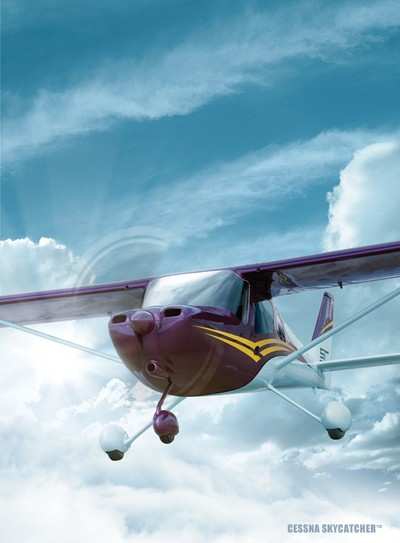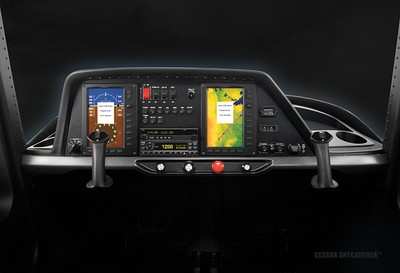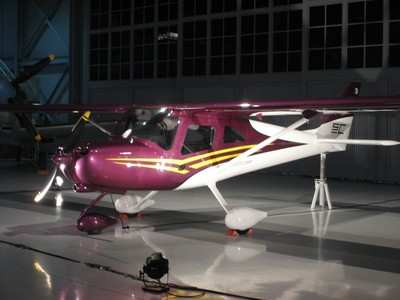Say Hello To SkyCatcher
Getting a jump start on major announcements at AirVenture 2007,
in a Sunday morning press conference Cessna Aircraft Company
provided further details on its upcoming light sport aircraft
entry... the Model 162 "SkyCatcher."

Specifications
Sporting the same general, aluminum-bodied configuration as the
proof-of-concept model unveiled last year at AirVenture 2006, the
SkyCatcher -- "that's what it is, and that's what it does," says
Cessna Chairman, President and CEO Jack Pelton -- sports a high,
strut-supported straight wing... rather than the forward-kicked
wing seen on the LSA POC, as well as the Next-Generation Piston
proof-of-concept. Cessna states the change was made to bring the
stall speed down below 45 knots, as required by the light sport
aircraft guidelines.

The aircraft, slated to enter service in late-2009 (more on that
in a moment), will be powered by a variant of the evergreen
Continental O-200 engine. The same engine powered the original
Cessna 150, as well as current light-sport aircraft such as the
Legend Cub, and AMD Zodiac.

Cessna is awaiting a lower-weight version of the engine,
however, dubbed the O-200D. Company representatives tell ANN they
target at least a 25-lb. weight reduction.
Any weight reduction will be welcome... as Cessna quotes an
empty weight for the SkyCatcher of 830 lbs. That's on the high side
of the light sport aircraft market, though Cessna notes this
amounts to a weight reduction of 290 lbs over a C-150. That figure
leaves 490 lbs for useful load, before butting up against the 1,320
lbs maximum gross weight allowance for LSA. Fuel capacity is 24
gallons US.

Range is also less than some LSAs, with a quoted figure of 470
nautical miles. It's clear the aircraft is optimized for
short training hops around the pattern, or quick cross-country
legs.
Interior
Though traditional Cessna in exterior appearance and engine
configuration, on the inside the SkyCatcher sports several
innovations... including a new standard Garmin-sourced glass panel.
All SkyCatchers will come with the new G300 panel, combining PFD
and MFD onto a single screen. A dual-screen variant of the system
is optional, and Cessna will have exclusive rights to the G300 for
the foreseeable future.

The aircraft sports a 44.5"-wide interior -- same as a Cessna
206 Stationair, but less than some other LSAs. To save
weight, all interior surfaces are painted, and not trimmed in
plastic. Pelton notes this also eliminates the trouble of cracked
trim pieces, endemic to older, Royalite-plagued Cessnas.

Perhaps the most novel feature, and the single most radical
departure from the Cessna single-engine-piston norm, is the control
stick arrangement. Yes, that's right -- stick. For the first time
since the Cessna 188 ag plane, the SkyCatcher will come with dual
control sticks... but arranged cleverly, with all hardware under
the panel, instead of protruding through the floor.
This arrangement clears floor space, to assist with ease of
entry. Thin, fixed, carbon-fiber-framed seats are another depature
from the Cessna norm.
Production Realities
Though much of the development work is complete on the aircraft,
there remain enough variables -- including lessons to be learned
throughout flight testing, slated to begin in early 2008
-- for Cessna to take a conservative approach to production. As
mentioned previously, entry-into-service is planned for the second
half of 2009.
There also remains the question of where the LSA will be
assembled. Though the decision has likely already been made,
Cessna representatives told ANN that piece of information isn't
quite ready for public consumption.

Now, the final question -- price. Alas, dreams of a
sub-$100K new Cessna aircraft will not become reality, due to what
Pelton termed production and product liability costs.
Cessna offers the LSA at an introductory price of $109,500 for
the first 1,000 aircraft; after that time, base price will
increase to $111,500.
Even that price, Pelton said, undercuts all comparably-equipped
(i.e, glass-panel-equipped) LSA competition. Of course, several
extra-cost options will be available -- including an emergency
parachute system (a first from the factory for Cessna), 406 mHz
ELT, and wheelpants and different exterior graphics schemes.
Target Market
Though specifics of its marketing plan haven't been ironed
out, Cessna is quite clearly targeting young, aspiring
pilots -- and the Cessna Pilot Centers who will train them --
for the SkyCatcher. Pelton touted the company's close
partnership with the EAA (organization president Tom Poberezny has
ordered the first two SkyCatchers off the line, one of which will
go to the Young Eagles program) as another avenue to attract
SkyCatcher fliers.

Somewhat left behind in Cessna's approach are older pilots, who
are attracted to the sport pilot category due to medical
issues.
 Classic Aero-TV: The Switchblade Flying Car FLIES!
Classic Aero-TV: The Switchblade Flying Car FLIES! ANN FAQ: Q&A 101
ANN FAQ: Q&A 101 ANN's Daily Aero-Term (04.12.24): Discrete Code
ANN's Daily Aero-Term (04.12.24): Discrete Code ANN's Daily Aero-Term (04.13.24): Beyond Visual Line Of Sight (BVLOS)
ANN's Daily Aero-Term (04.13.24): Beyond Visual Line Of Sight (BVLOS) ANN's Daily Aero-Linx (04.13.24)
ANN's Daily Aero-Linx (04.13.24)










